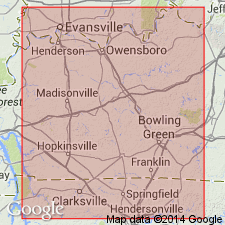
- Usage in publication:
-
- Camp Nelson beds
- Modifications:
-
- Named
- Dominant lithology:
-
- Limestone
- AAPG geologic province:
-
- Cincinnati arch
Summary:
Named for village of Camp Nelson, Jessamine Co, KY. Mainly composed of limestone, very massive and breaking with conchoidal fracture. Some beds of whitish shale, not over 3 or 4 feet in thickness, are present. Base not exposed, below surface of Kentucky River. Total measured exposed thickness is 285 ft. Overlain by Oregon bed.
Source: GNU records (USGS DDS-6; Reston GNULEX).
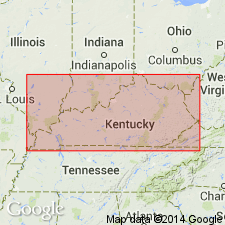
- Usage in publication:
-
- [Camp Nelson limestone]
- Modifications:
-
- Revised
- AAPG geologic province:
-
- Cincinnati arch
Summary:
Pg. 11-12. Camp Nelson [limestone] of High Bridge group. "Limestone composed of irregular patches and ramifications of granular rock of the Oregon type, interpreted as branching fucoids and presumably algal in origin, distributed through a matrix of dense limestone of the Tyrone type. On weathering the surface becomes honeycombed. Fossils are not common. The more characteristic are MACLURITES BIGSBYI, ESCHAROPORA RAMOSA, RHINIDICTYA TRENTONENSIS, and various cephalopods. Thickness, about 300 feet exposed above drainage." Is lowermost formation in High Bridge (Highbridge) group. Underlies Oregon [limestone]. Age is Ordovician.
[On p. 12 (footnote) author states correlations have been changed in 1941 ed. of Schuchert and Dunbar's Historical Geology (John Wiley and Sons). Formations of the High Bridge placed in the Mohawkian; extend from upper Black River into lower Trenton. Camp Nelson along with the Oregon placed in upper Black River and correlated with the Lowville and Chaumont, respectively, of the New York section. The Tyrone was removed from the Lowville and placed at base of the Trenton (Rockland). In subsequent years, these correlations were adopted by most geologists; see also 1954 Correlations of the Ordovician Formations of North America, GSA Bull., v. 65.]
Source: Publication; US geologic names lexicon (USGS Bull. 1200, p. 598); GNC index card files (USGS-Reston).
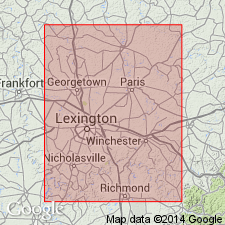
- Usage in publication:
-
- Camp Nelson limestone*
- Modifications:
-
- Revised
- AAPG geologic province:
-
- Cincinnati arch
Summary:
Pg. 40-41. Camp Nelson limestone of High Bridge group. Lowermost formation in High Bridge group. Underlies Oregon limestone. Essentially a lithographic type limestone, but contains many recognizable masses of magnesian limestone. Maximum thickness about 310 feet, base not exposed. [Age is Middle Ordovician.]
Source: GNU records (USGS DDS-6; Reston GNULEX).
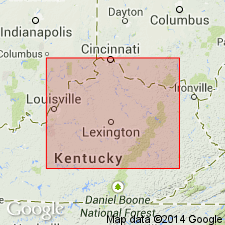
- Usage in publication:
-
- Camp Nelson limestone*
- Modifications:
-
- Age modified
- AAPG geologic province:
-
- Cincinnati arch
Summary:
Age modified to Middle Ordovician.
Source: GNU records (USGS DDS-6; Reston GNULEX).
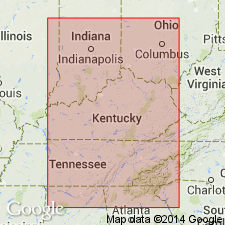
- Usage in publication:
-
- Camp Nelson Limestone*
- Modifications:
-
- Overview
- AAPG geologic province:
-
- Cincinnati arch
Summary:
The Camp Nelson Limestone of the High Bridge Group in KY consists of micrite, pelmicrite, and biopelmicrite with burrows that are sometimes dolomitized. Base of unit is not exposed. Overlies the Wells Creek Dolomite in the subsurface and underlies the Oregon Formation. The environment of deposition is considered to be shallow subtidal. Fossils in the biomicrite include ostracodes, trilobites, brachiopods, corals, bryozoans, pelecypods, and nautiloids. The Camp Nelson is of Middle Ordovician age.
Source: GNU records (USGS DDS-6; Reston GNULEX).
For more information, please contact Nancy Stamm, Geologic Names Committee Secretary.
Asterisk (*) indicates published by U.S. Geological Survey authors.
"No current usage" (†) implies that a name has been abandoned or has fallen into disuse. Former usage and, if known, replacement name given in parentheses ( ).
Slash (/) indicates name conflicts with nomenclatural guidelines (CSN, 1933; ACSN, 1961, 1970; NACSN, 1983, 2005, 2021). May be explained within brackets ([ ]).

